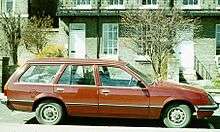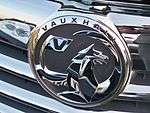Vauxhall Carlton
| Vauxhall Carlton | |
|---|---|
 Pre-facelift Carlton Mk 1 saloon | |
| Overview | |
| Manufacturer | Vauxhall (General Motors) |
| Also called |
Opel Rekord E Opel Omega A |
| Production | 1978–1994 |
| Assembly |
Luton, United Kingdom Rüsselsheim, West Germany |
| Body and chassis | |
| Class | Executive car |
| Body style |
4-door saloon 4-door estate |
| Layout | FR layout |
| Related |
Opel Rekord |
| Chronology | |
| Predecessor | Vauxhall Victor/VX series |
| Successor | Vauxhall Omega |
The Vauxhall Carlton is a series of large family car/executive car sold in two distinct generations by the Vauxhall division of GM Europe between 1978 and 1994. The Carlton was based on the Opel Rekord E (Mk.1) and Omega A (Mk.2).
With the exception of the pre-facelift Mk.1 cars, most Carltons were manufactured by Opel in Rüsselsheim, and differed only from their Opel Rekord/Omega sisters in badging and trim.
It was replaced by the Omega B in 1994, mirroring the standardisation of model names across both GM Europe brands.
Mark I (1978–86)
Main Article: Opel Rekord E

The first Vauxhall Carlton was introduced in late 1978 as a replacement for the ageing VX1800/VX2300 saloons. Based on the Opel Rekord, but with Vauxhall's typical "droop snoot" front end that featured no traditional grille. The other difference was the dashboard, which featured the hooded instrument binnacle going across the whole width of the car with wooden embellishment, compared to the plainer dash of the Rekord. It was a traditional large saloon or estate with rear-wheel drive and a spacious, comfortable interior and was available in "L" trim only. Power came from a 2.0–litre carburettor petrol engine which gave reasonable performance, refinement and economy. There were some impressive options available, including central door locking, alloy wheels and electric windows, which in the late 1970s were relatively plush equipment on mainstream cars.
Relationship with other models
Lengthened, more powerful models, based on the Carlton and Rekord, were also available. Positioned directly above them was the Vauxhall Viceroy which was a Carlton with the larger 2.5 L or 3.0 L six-cylinder CIH engine (the corresponding Opel was the Opel Commodore), and differed also in that it featured a chrome grille with the "white cross" motif (from the VX4/90) in place of the Carlton's painted droop snoot nose. The Viceroy/Commodore however sold poorly and were discontinued after the "E2" facelift in 1982, and a 6-cylinder engine would not appear in the Carlton again until the Mk.2 GSi 3000 model.
The Vauxhall Royale and Vauxhall Royale Coupé were in essence, long wheelbase versions of the Carlton/Viceroy with altered "six light" styling that were positioned at the top end of the range only featuring six-cylinder engines. These were essentially badge engineered versions of the Opel Senator and Monza, respectively, although a confusing situation resulted in the United Kingdom as a result of General Motors' decision to merge the Vauxhall and Opel dealer networks and marketing - the Royale was dropped in 1983 in favour of its Opel equivalents, only for the Senator to revert back to being badged as a Vauxhall again for the 1985 model year.
.jpg)
Facelift
The introduction of the facelifted "E2" Opel Rekord for the 1983 model year, marked the convergence of both it and the Carlton, with both cars now differing only in badging, whilst UK production of the Carlton was stopped and was now sourced from Rüsselsheim. The update saw the disappearance of the droop snoot front, in favour of a more traditional (though still angled) grille shared with the Rekord. Both cars also shared the new dashboard moulding and redesigned interior. This also marked the end of UK sale of the Opel Rekord as the Opel brand was being phased out in the UK.
The 1983 facelift also saw the introduction of a wider engine range with the Family II engine from the Ascona/Cavalier in a 1.8 L carburettor form, whilst the older Opel CIH unit continued in the 2.0 L carburettor and 2.0 L fuel injection form. In 1984, a range topping 2.2 L CIH fuel injected petrol became available in the CD trim. A 2.3 L diesel version was also available . A wider range of trim levels consisting of "L", "GL" and "CD" were also introduced at this time. A 2.0 L fuel injection engine was introduced for the 1984 model year and was replaced by a 2.2 L fuel injection engine for 1985.
Mark II (1986–94)
Main Article: Opel Omega A
.jpg)
.jpg)
Opel chose to name its 1986 replacement car in this segment Omega rather than Rekord. Vauxhall stayed with the Carlton name. On its launch at the end of 1986 the Vauxhall Carlton / Opel Omega saloon and estate range earned itself the accolade of European Car of the Year.
Relationship with other models
Again there was a lengthened version of the Carlton (and Omega), this time known in both Opel and Vauxhall forms by the same name: Senator.
Vauxhall scrapped the Carlton nameplate in early 1994, but the name of its Opel equivalent, the Omega, lived on, as it was applied to the Carlton's replacement. At which point the Vauxhall equivalent adopted the name change (a drive towards uniformity was taking place throughout the range) and so the Carlton's replacement was sold as the Vauxhall Omega.
Mark II engine line-up
All of the 4-cylinder engines available in the Carlton Mk II were the GM Family II units in 1.8L and 2.0L capacities. The Opel Omega A was offered with a large 2.4L Opel CIH engine in certain European markets, but this variant was never offered in the Carlton. New to the Carlton's line-up with the Mark II were two straight-6 engines with 2.6 and 3.0–litres. These were both 12-valve engines, again from the Opel CIH family, but later 3.0-liter models were offered with 24-valves, producing much more power and torque. As well, Vauxhall used the "Dual-Ram" intake manifold, which lets the car breathe as two separate three-cylinder engines below 4,000 rpm, but changes the intake manifold profile at 4000 rpm to increase the runner length, thus increasing total engine output.
In addition to the straight-6 engines there was a range of straight-4s. Starting with GMs popular 2-litre family 2 engine, the C20NE, with 115PS and 125lb.ft torque. There was also a 2.3 turbo diesel available with 100PS and 160lb.ft torque.
Special Lotus version
In 1990, Vauxhall launched a high performance 377 bhp (281 kW) Lotus Carlton in collaboration with Lotus Cars. (An Opel version was also produced as the Lotus Omega.) It was built with a 3615 cc six-cylinder twin-turbo engine (designated C36GET) capable of over 176 mph (283 km/h), making it officially (for the time) the fastest full four-seater that had ever been made. It cost £48,000 – well over double the price of a standard Carlton. As a result, Vauxhall's original plans to sell about 1,000 in the UK ended in 440 UK cars being sold. For those with less money there was the 3000GSi 24v, with a top speed of 146 mph (235 km/h).
GSi 3000
.jpg)
Prior to the Lotus tuned version, the range topper was the GSi 3000 upon which the Lotus Carlton was based. At launch in 1986 it had 177 bhp (132 kW; 179 PS) giving it a top speed of 134 mph (216 km/h). In 1990, power was increased by going from 12 valves to 24, resulting in 204 bhp (152 kW; 207 PS) which allowed 0-62 mph to be dispatched in 7.6 seconds and increased the top speed to 149 mph (240 km/h). It was also available with an Automatic gearbox, which reduced the top speed to 146 mph (235 km/h) and increased the 0–62 mph time to 8.6 seconds. All but 90 versions of the Carlton GSi were sold as saloons, with the Diamond estate version proving far less popular.
Guinness World Record
In June 1992 two teams from Horley Round Table, Surrey, UK, set a Guinness World Record time of 77 hours 34 minutes, driving a total 6,700 km across the then 12 EC countries in two Vauxhall Carlton 24V 3000 GSi's (J870 FFM and J751 DYC). The Carltons were provided by Vauxhall Motors and the record attempt was also supported by Mobil Oil and the Royal Automobile Club.
Survival rate
By February 2016, just 468 examples of the Carlton were still on Britain's roads, with most remaining examples believed to be the high performance 3000 GSi and Lotus versions of the MK2 model.[1]
References
External links
| Wikimedia Commons has media related to Vauxhall Carlton. |
